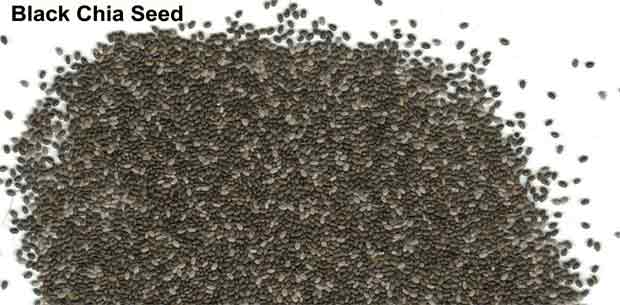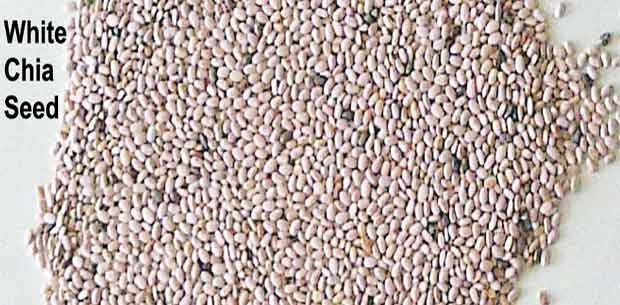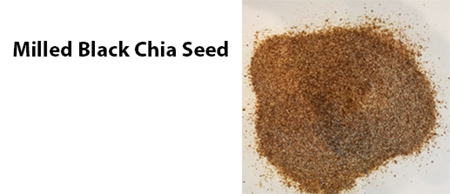Chia Seed as a source of Antioxidants and Fiber
Antioxidants
Analysis of chia seed press cake left following removal of the oil has been shown to possess strong antioxidant activity (Taga et al., 1984). These antioxidants make chia a very stable source of ω-3 fatty acids, and explains why the Aztecs were able to store chia seed and flour for extended periods of time without becoming rancid.
The most important antioxidants in chia are chlorogenic acid and caffeic acid, but it also contains myricetin, quercetin and kaempferol flavonols. These compounds are both primary and synergistic antioxidants, and contribute to the strong antioxidant activity of chia (Taga et al., 1984; Castro-Martinez et al., 1986).
Caffeic acid and chlorogenic acid, have been shown to exhibit strong free radical and superoxide scavenging activity, and to inhibit lipid peroxidation. These antioxidant properties are significantly stronger than those of ferulic acid as well as common antioxidants such as vitamin C (ascorbic acid) and vitamin E (α-tocopherol) (Kweon et al., 2001). Research also has shown that quercetin is a powerful antioxidant which can prevent oxidation of lipids, proteins, and DNA, and that its antioxidant properties are significantly more effective than other flavonols (Makris and Rossiter, 2001).
Epidemiological studies indicate that consumption of high levels of flavonol-rich foods and beverages may protect against CHD (Hertog et al., 1993, 1995; Hertog and Hollman,1996; Cook and Samaman, 1996; Knekt et al., 1996), stroke (Keli et al., 1996), lung cancer (Knekt et al., 1997), and stomach cancer (Garcia Closas et al., 1999). In particular flavonoids such as quercetin have been reported to inhibit platelet adhesion to collagen and collagen-induced platelet aggregates, and could explain the relationship between these antioxidants and a decreased risk of cardiovascular disease (Pignatelli et al., 2000; Hirovonen et al., 2001).
Lipid oxidation in foods is a problem, particularly with polyunsaturated ω-6 and ω-3 fatty acids. If not controlled oxidation produces not only off-flavors in food (typically a fishy flavor), but also promotes aging and the degenerative diseases of aging such as cancer, cardiovascular diseases, cataracts, immune system decline, and brain dysfunction (Okuyama et al., 1997).
In foods containing antioxidants, oxidation and loss of palatability due to generation of off-flavors is slowed. Synthetic as well as natural antioxidants can be added to foods, however recent trends have been away from synthetic products because of the suspicion that these compounds may promote carcinogenicity (White and Xing, 1997).
Chia, when used as an ω-3 source, does not require the use of artificial antioxidants such as vitamins. Antioxidant vitamins have been shown to nullify the protector effects of cardiovascular drugs. As examples vitamin E, vitamin C, and β-carotene reduce the increase in high density lipoprotein (HDL) cholesterol levels the drug simvastatin (a cardiovascular protection compound) can achieve (Brown et al., 2001).
Dietary Fiber
Dietary fiber has been found to improve the management of diabetes mellitus, and aids in the prevention of coronary artery disease and a number of chronic disorders. For these reasons a variety of organizations (including the Institute of Medicine – www.iom.edu) recommend consumption of dietary fiber to be approximately 25 grams per day, with a range of 20-35 grams being desirable, with the fiber coming from both soluble and insoluble sources.
The benefits of consuming a high-carbohydrate, high-fiber, low-fat diet on blood glucose levels has been demonstrated (Odea et al.,1989). Soluble fiber increases intestinal transit time, delays gastric emptying and slows the rate of glucose absorption, thereby reducing cholesterol absorption (Anderson et al., 1984; Marlett et al., 1994). These actions lower postprandial blood glucose, and decrease both total and LDL-cholesterol concentrations. According to the American Association of Cereal Chemists (2001) “One of the means of directly measuring an immediate physiological effect of dietary fiber and high fiber foods is the attenuation of glucose level in the blood for several hours after ingestion of the food”.
Comparing the fiber content of chia with traditional cereals, chia seed has more fiber per 100 grams of an edible portion than does barley, wheat, oats, corn, and rice.
Cereal fibers of medium-to-large particle size appear to have little effect on small intestine absorption (Jenkins et al., 1994). Chia seed contains about 5% soluble fiber which appears as clear mucilage when it is placed in water. This remains tightly bound to the seed and has a very large molecular weight, averaging 1.5 x 106 Dalton (Lin and Daniel, 1994). The high viscosity of chia mucilage renders it more likely to produce desired metabolic effects than lower viscosity dietary fibers such as guar or beta-glucan (Wood et al., 1989). Hence chia is useful as a dietary fiber, and because of this may possess application in the food industry (Whistler, 1982; Weber et al., 1991; Lin and Daniel, 1994).
References
American Association of Cereal Chemists. 2001. The definition of dietary fiber. Cereal Foods Word, 46(3):112-126.
Anderson, J.W., L. Story, B. Sieling, W.J. Chen, M.S. Perto, and J. Story. 1984. Hypocholesterolemic effects of oat-bran or bean intake for hypercholeterolemic men. American Journal of Clinic Nutrition, 40:1146-1155.
Brown, B.G., X.Q. Zhao, A. Chait, L.D. Fisher, M.C. Cheung, J.S. Morse, A.A. Dowdy, E. K. Marino, E. L. Bolson, P.Alaupovic, J.A. Frohlich, and J.J. Albers. 2001. Simvastatin and niacin, antioxidant vitamins or the combination for the prevention of coronary disease New England Journal of Medicine 345(22):1583-92.
Castro-Martinez, R., D.E. Pratt, and E.E. Miller.1986. Natural antioxidants of chia seeds. Proceedings of the World Conference on Emerging Technologies in the Fats and Oils Industry, edited by the American Oil Chemists’ Society, Champaign, Illinois, USA, pp. 392-396.
Cook, N.C. and S. Samaman. 1996. Flavonoids: chemistry, metabolism, cardio protective effects, and dietary sources. The Journal of Nutritional Biochemistry, 7:66-76.
Garcia-Closas, R., C.A. Gonzalez, A. Agudo, and E. Riboli. 1999. Intake of specific carotenoids and flavonoids and the risk of gastric cancer in Spain. Cancer Causes and Control, 10:71-75.
Hertog, M.G.L., and P.C. H. Hollman. 1996. Potential health effects of the dietary flavonol quercetin. European Journal of Clinical Nutrition 50:63-71.
Hertog, M.G., D. Kromhout, and C. Aravanis. 1995. Flavonoid intake and long-term risk of coronary heart disease and cancer in the seven countries study. Archives of Internal Medicine, 155(4):381-386.
Hertog MG, E.J. Feskens, P.C. Hollman, M.B. Katan, and D. Kromhout. 1993. Dietary antioxidant flavonoids and risk of coronary heart disease: the Zutphen Elderly Study. Lancet. 342(8878):1007-1011.
Hirovonen, T., P. Pietinen, M. Virtanen, M.L. Ovaskainen, S. Hakkinen, D. Albanes, and J. Virtamo. 2001. Intake of flavonols and flavones and risk of coronary heart disease in male smokers. Epidemiology, 12(1):62-67.
Jenkins, D.J.A., A.L. Jenkins, T.M.S. Wolever, and V. Vuksan. 1994. Fiber and physiological and potentially therapeutic effects of slowing carbohydrate absorption. In: New Developments in Dietary Fiber: Physiological, Physicochemical and Analytical Aspects, edited by I, Furda, and J. Brine. Plenum Press, New York, New York, USA, pp.129-134.
Keli, S.O., M.G. Hertog,, E.J. Feskens, and D. Kromhout. 1996. Dietary flavonoids, antioxidant vitamins, and incidence of stroke: the Zutphen study. Archives of Internal Medicine,156(6):637-
642.
Knekt P, R. Jarvinen, R. Seppanen, M. Hellovaara, L. Teppo, E. Pukkala, and A. Aromaa. 1997. Dietary flavonoids and the risk of lung cancer and other malignant neoplasms. American Journal of Epidemiology, 146(3):223-230.
Knekt, P., R. Jarvinen, A. Reunanen, and J. Maatela. 1996. Flavonoid intake and coronary mortality in Finland: a cohort study. British Medical Journal, 312(7029):478-481.
Kweon, M.H., H.J. Hwang, and H.C. Sung. 2001. Identification and antioxidant activity of novel chlorogenic acid derivatives from bamboo (Phyllostachys edulis). Journal of Agriculture Food and Chemistry, 49:4646-4655.
Lin, K.Y., J.R. Daniel, and R.L. Whistler. 1994. Structure of chia seed polysaccharide exudate. Carbohydrate Polymers, 23:13-18.
Makris, D.P. and J.T. Rossiter. 2001. Comparison of quercetin and a non-orthohydroxy flavonol as antioxidant by competing in vitro oxidation reactions. Journal of AgricultFood and Chemistry, 49:3370-3377.
Marlett, J.A., K.B. Hosig, N.W. Vollendorf, F.L. Shinnik, V.S. Haack, and J.A. Story. 1994. Mechanism of serum cholesterol reduction by oat bran. Hepatology, 20:1450-1457.
Odea, K., K. Traianedes, P. Ireland, M. Niall, J. Sadler, J. Hopper, and M. De Luise. 1989. The effects of diet differing in fat, carbohydrate, and fiber on carbohydrate and lipid metabolism in type II diabetes. Journal of American Dietetic Association, 89(8):1076-1086.
Okuyama, H., T. Kobayashi, and S. Watanabe. 1997. Dietary fatty acids – the n-6/n-3 balance and chronic elderly diseases excess linoleic acid and relative n-3 deficiency syndrome seen in Japan. Progress in Lipid Research, 35(4):409-457.
Pignatelli, P., F.M. Pulcinelli, A. Celestini, L. Lenti, A. Ghiselli, P.P. Gazzaniga, and F. Violi. 2000. The flavonoids quercetin and catehin synergistically inhibit platelet function by antagonizing the intracellular production of hydrogen peroxide. American Journal of Clinical Nutrition, 72:1150-1155.
Taga, M.S., E.E. Miller, and D.E. Pratt, 1984. Chia seeds as a source of natural lipid antioxidants. Journal of American Oil Chemists’ Society, 61:928-931.
Weber, C.D. and Ch. Lim. 2002. Introduction to fish nutrition. In: Nutrient Requirements and Feeding of Finfish for Aquaculture, edited by C.D. Webster and C. Lim.. CAB International Publishing, Wallingford, Oxfordshire, UK, pp. 1-27.
Whistler, R.O. 1982. Industrial gums from plants: guar and chia. Economic Botany, 36:195-202.
White, P,J. and Y. Xing. 1997. Antioxidants from cereals and legumes. In: Natural Antioxidants: Chemistry, Health Effects and Applications, edited by F. Shahidi. American Oil Chemists´ Society, Champaign, Illinois, USA, pp. 25-63.
Wood, P.J., J.W. Anderson, J.R. Braaten, N.A. Cave, F.W. Scott and C. Vachon. 1989. Physiological effects of beta D glucan rich fractions from oats. Cereals Food World, 34(10):878:882.







